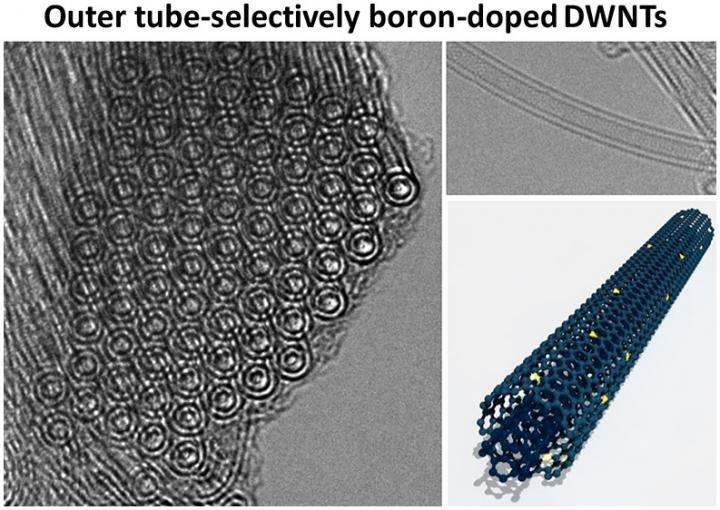
Credit: Copyright © 2020, American Chemical Society
Carbon nanotubes, the tiny hollow tube of hexagonal carbon lattices has been touted as one of the most promising materials for building items with fascinating electrical, thermal and mechanical properties. Selective functionality is realized by adding elements to the carbon nanotubes to make transistors, composite additives, field emitters and transparent conductive films. Carbon nanotubes doped with boron makes the structure of the tubes more functional while increasing the ability to modulate the electrical properties. Boron-doping into coaxially aligned two single-walled carbon nanotubes (double-walled carbon nanotubes :DWNTs) show promise for use in electronic devices, composite materials, energy storage and power generation materials.
A research group led by Hiroyuki Muramatsu of Shinshu University succeeded in selectively doping the outer nanotube of the DWNTs with boron. Previously, there was no method to control the incorporation of boron atoms to carbon nanotubes. The tubes would fuse together or the structure would drastically change through treatments of boron-doping, frustrating researchers. In this study, Muramatsu and his team were able to selectively add boron to the outer tubes of DWNTs. This significantly increased the electrical conductivity and the Seebeck coefficient which resulted in a highly enhanced thermoelectric performance of the DWNTs.
This advancement in technique allows for an extremely effective method to add functionality such as high electrical conductivity, chemical activation and improvement of thermoelectric properties while maintaining the function of the inner CNT. Muramatsu and his team succeeded in discovering the conditions for intricately doping boron on a single outermost layer of CNT without changing the coaxial structure of DWNTs. Only then were they able to actually demonstrate and confirm the characteristics of the synthesized DWNTs.
In the future boron-doped DWNTs could be used in thermoelectric applications to harvest waste heat for electricity generation and other advanced applications. However, DWNTs are still not very well understood. Muramatsu believes that through fundamental research and understanding the basic properties of outer tube-selectively boron-doped DWNTs, more applications can be found while enhancing performance relevant to various applications. The ultimate goal is to strategically use the characteristics of the structure and physical properties of DWNTs to add unique functions and characteristics. New principles and methods must be investigated in detail to establish a more selective high-concentration doping method and study its effect on the structure and function.
###
Media Contact
Hitomi Thompson
[email protected]
Related Journal Article
http://dx.




